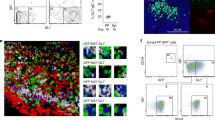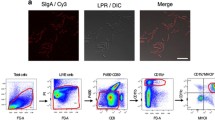Abstract
The gastroinstestinal mucosa is continously exposed to food-derived antigens, resident microorganisms and invading pathogens. Correct antigen sampling and handling is essential for regulation and maintenance of mucosal immune responses against these factors However, antigen transport through the epithelium, uptake, processing and presentation by specialized cells in vivo are important steps in the initiation of a defined immune response (or tolerance) in the gut.
Access this chapter
Tax calculation will be finalised at checkout
Purchases are for personal use only
Preview
Unable to display preview. Download preview PDF.
Similar content being viewed by others
References
B.L. Kelsall and W. Strobel-. Distinct population of dendritic cells are present in the subepithelial dome and T cell region of murine Peyer’s patch. J. Exp. Med. 183: 237 (1996)
C. Ruedl, C. Rieser, G. BÖck, G. Wick and H. Wolf. Phenotypic and functional characterization of CD 11c+ dendritic cell population in mouse Peyer’s patches. Eur. J. Immunol 26: 1801–1806 (1996).
G. Girolomoni. J.C. Simon, P.R. Bergstresser and P.D. Cruz. Freshly isolated spleen dendritic cells and epidermal Langerhans cells undergo similar phenotypic and functional changes during short term culture. J. Immunol. 145: 2820 (1990)
N. Romani and G. Schuler. The immunologic properties of epidermal Langerhans cells as a part of the dendritic cell system. Springer Semin. Immunopathol. 13: 265 (1992).
U. O’Doherty, M. Peng, S Gezelter, W.J. Swiggard, M. Betjes, N. Bhardwaj and R.M. Steinman. Human blood contains two subsets of dendritic cells, one immunological mature and the other immature. Immunology 82: 487 (1994).
Author information
Authors and Affiliations
Editor information
Editors and Affiliations
Rights and permissions
Copyright information
© 1997 Springer Science+Business Media New York
About this chapter
Cite this chapter
Ruedl, C., Hubele, S., Rieser, C., Wolf, H. (1997). The Role of CD11c+ Cells as Possible Candidates for Immature Dendritic Cells in the Murine Peyer’s Patches. In: Ricciardi-Castagnoli, P. (eds) Dendritic Cells in Fundamental and Clinical Immunology. Advances in Experimental Medicine and Biology, vol 417. Springer, Boston, MA. https://doi.org/10.1007/978-1-4757-9966-8_18
Download citation
DOI: https://doi.org/10.1007/978-1-4757-9966-8_18
Publisher Name: Springer, Boston, MA
Print ISBN: 978-1-4757-9968-2
Online ISBN: 978-1-4757-9966-8
eBook Packages: Springer Book Archive




